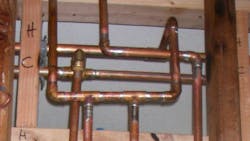For example, as long as I had to install additional plumbing, I thought I’d be clever by upgrading some of the existing plumbing in the basement to minimize flow restrictions. I did this by using ¾-in. tubing, fittings, and valves instead of ½ in. — plus I?used ball valves instead of the standard globe valves. My thinking was that minimizing restrictions would maximize flow rate. This would make running water for a bath, doing a load of laundry, or filling a pitcher of water go quicker because the water would flow faster. Sounds reasonable, but my great idea backfired.
What I neglected to account for was fluid conductivity — also known as flow coefficient, or Cv — a topic we discuss somewhat regularly in this magazine. Basically, when you have a series of restrictions (fittings, valves, and the tubing itself), and one restriction is considerably greater than any of the others, that restriction affects system flow more than all of the other restrictions combined. In my case, faucets at the end of each run all have relatively narrow passageways, so the restriction created by the faucet is considerably higher than anything else in that run. Consequently, using larger components upstream has not increased flow from any faucet.
The ¾-in. tubing, in fact, has a negative effect, because it holds roughly twice as much water as ½-in. tubing does. So when I want hot water from the faucet, it takes twice as long for the water to get hot because twice as much cold water must first flow from the ¾-in. tubing before hot water reaches the faucet. The water doesn’t flow any faster, plus it takes longer to get hot water, which increases energy used by the water heater.
But all is not lost. I still think it was a good idea to use the ball valves. They work quickly and effortlessly and achieve a leak-tight seal. The unrestricted, straight-through design poses no real benefit for my application, but I certainly can see the advantages for fluid power systems. Not only that, but they look great. A finished assembly of copper elbows, tees, tubing, and brass valves all soldered together is a thing of beauty. It seems a shame to hide it deep within the framework of my house where no one will see it. So now I can appreciate what designers of fluid power systems go through. After weeks of discussion, design, revision, construction, testing, more discussion, and maybe more revision, the reward for a designer is seeing his or her work become such an integral part of a machine that few observers are even aware that fluid power is at work.
But at least designers in industry can make prototypes, which gives them the chance to iron out unforeseen problems. Better still are simulation programs, which allow designers to test their work as a virtual machine. I didn’t use simulation to test my idea, so I’ll just have to live with the finished design, which also happens to be the prototype.
About the Author
Alan Hitchcox Blog
Editor in Chief
Alan joined Hydraulics & Pneumatics in 1987 with experience as a technical magazine editor and in industrial sales. He graduated with a BS in engineering technology from Franklin University and has also worked as a mechanic and service coordinator. He has taken technical courses in fluid power and electronic and digital control at the Milwaukee School of Engineering and the University of Wisconsin and has served on numerous industry committees.

Leaders relevant to this article:

